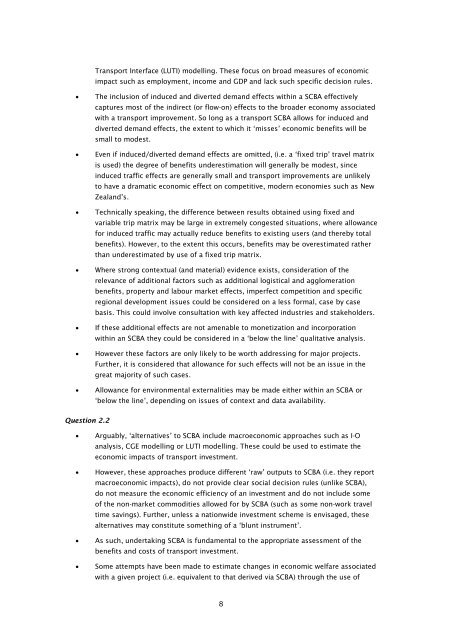Research 350 - NZ Transport Agency
Research 350 - NZ Transport Agency
Research 350 - NZ Transport Agency
Create successful ePaper yourself
Turn your PDF publications into a flip-book with our unique Google optimized e-Paper software.
<strong>Transport</strong> Interface (LUTI) modelling. These focus on broad measures of economic<br />
impact such as employment, income and GDP and lack such specific decision rules.<br />
• The inclusion of induced and diverted demand effects within a SCBA effectively<br />
captures most of the indirect (or flow-on) effects to the broader economy associated<br />
with a transport improvement. So long as a transport SCBA allows for induced and<br />
diverted demand effects, the extent to which it ‘misses’ economic benefits will be<br />
small to modest.<br />
• Even if induced/diverted demand effects are omitted, (i.e. a ‘fixed trip’ travel matrix<br />
is used) the degree of benefits underestimation will generally be modest, since<br />
induced traffic effects are generally small and transport improvements are unlikely<br />
to have a dramatic economic effect on competitive, modern economies such as New<br />
Zealand’s.<br />
• Technically speaking, the difference between results obtained using fixed and<br />
variable trip matrix may be large in extremely congested situations, where allowance<br />
for induced traffic may actually reduce benefits to existing users (and thereby total<br />
benefits). However, to the extent this occurs, benefits may be overestimated rather<br />
than underestimated by use of a fixed trip matrix.<br />
• Where strong contextual (and material) evidence exists, consideration of the<br />
relevance of additional factors such as additional logistical and agglomeration<br />
benefits, property and labour market effects, imperfect competition and specific<br />
regional development issues could be considered on a less formal, case by case<br />
basis. This could involve consultation with key affected industries and stakeholders.<br />
• If these additional effects are not amenable to monetization and incorporation<br />
within an SCBA they could be considered in a ‘below the line’ qualitative analysis.<br />
• However these factors are only likely to be worth addressing for major projects.<br />
Further, it is considered that allowance for such effects will not be an issue in the<br />
great majority of such cases.<br />
• Allowance for environmental externalities may be made either within an SCBA or<br />
‘below the line’, depending on issues of context and data availability.<br />
Question 2.2<br />
• Arguably, ‘alternatives’ to SCBA include macroeconomic approaches such as I-O<br />
analysis, CGE modelling or LUTI modelling. These could be used to estimate the<br />
economic impacts of transport investment.<br />
• However, these approaches produce different ‘raw’ outputs to SCBA (i.e. they report<br />
macroeconomic impacts), do not provide clear social decision rules (unlike SCBA),<br />
do not measure the economic efficiency of an investment and do not include some<br />
of the non-market commodities allowed for by SCBA (such as some non-work travel<br />
time savings). Further, unless a nationwide investment scheme is envisaged, these<br />
alternatives may constitute something of a ‘blunt instrument’.<br />
• As such, undertaking SCBA is fundamental to the appropriate assessment of the<br />
benefits and costs of transport investment.<br />
• Some attempts have been made to estimate changes in economic welfare associated<br />
with a given project (i.e. equivalent to that derived via SCBA) through the use of<br />
8
















